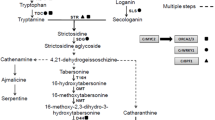Abstract
The rise in ethylene production accompanying the respiration climacteric and senescence of cut carnation flowers (Dianthus caryophyllus L. cv. White Sim) was associated with a 30-fold increase in the concentration of 1-aminocyclopropane-1-carboxylic acid (ACC) in the petals (initial content 0.3 nmol/g fresh weight). Pretreatment of the flowers with silver thiosulfate (STS) retarded flower senescence and prevented the increase in ACC concentration in the petals. An increase in ACC in the remaining flower parts, which appeared to precede the increase in the petals, was only partially prevented by the STS pretreatment. Addition of aminoxyacetic acid (2 mM) to the solution in which the flowers were kept completely inhibited accumulation of ACC in all flower parts.
Similar content being viewed by others
Abbreviations
- ACC:
-
1-aminocyclopropane-1-carboxylic acid
- AOA:
-
α-aminoxyacetic acid
- STS:
-
silver thiosulfate complex
References
Adams, D.O., Yang, S.F. (1979) Ethylene biosynthesis: Identification of 1-aminocyclopropane-1-carboxylic acid as an intermediate in the conversion of methionine to ethylene. Proc. Nat. Acad. Sci. USA 76, 170–174
Fujino, D.W., Reid, M.S., Yang, S.F. (1980) Effects of aminoxyacetic acid on postharvest characteristics of carnation. Acta Hortic., in press
Hoffman, N.E., Yang, S.F. (1980) Changes of 1-aminocyclopropane-1-carboxylic acid content in ripening fruits in relation to their ethylene production rates. J. Am. Soc. Hortic. Sci. 105, 492–495
Lieberman, M. (1979) Biosynthesis and action of ethylene. Ann. Rev. Plant Physiol. 30, 523–591
Lizada, M.C.C., Yang, S.F. (1979) A simple and sensitive assay for 1-aminocyclopropane-1-carboxylic acid. Anal. Biochem. 100, 140–145
Nichols, R. (1966) Ethylene production during senescence of flowers. J. Hortic. Sci. 41, 279–290
Nichols, R. (1971) Induction of flower senescence and gynaecium development in the carnation (Dianthus caryophyllus) by ethylene and 2-chloroethylphosphonic acid. J. Hortic. Sci. 46, 323–332
Nichols, R. (1977) Sites of ethylene production in the pollinated and unpollinated carnation (Dianthus caryophyllus) inflorescence. Planta 135, 155–159
Pratt, H.K. (1975) The role of ethylene in fruit ripeniug. In: Facteurs et regulation de la maturation des fruits. Colloques Int. du C.N.R.S. No. 238, 153–160
Reid, M.S., Paul, J.L., Farhoomand, M.B., Kofranek, A.M., Staby, G.L. (1980) Pulse treatments with the silver thiosulfate complex extend the vase life of cut carnations. J. Am. Soc. Hortic. Sci. 105, 25–27
Veen, H. (1979) Effects of silver on ethylene synthesis and action in cut carnations. Planta 145, 467–470
Yang, S.F. (1980) Regulation of ethylene biosynthesis. Hortic. Sci. 15, 238–243
Author information
Authors and Affiliations
Rights and permissions
About this article
Cite this article
Bufler, G., Mor, Y., Reid, M.S. et al. Changes in 1-aminocyclopropane-1-carboxylic-acid content of cut carnation flowers in relation to their senescence. Planta 150, 439–442 (1980). https://doi.org/10.1007/BF00390183
Received:
Accepted:
Issue Date:
DOI: https://doi.org/10.1007/BF00390183




